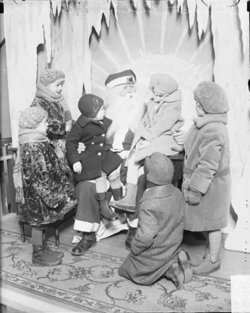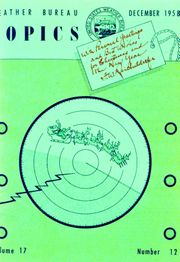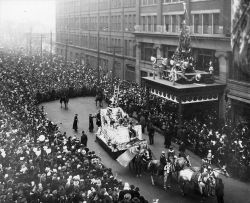
Several rituals have developed around the Santa Claus figure that are normally performed by children hoping to receive gifts from him.
Contents |
Christmas Eve rituals
In the United States and Canada, the tradition is to leave Santa a glass of milk and cookies; in Britain and Australia, he is sometimes given sherry and mince pies instead.
British, Australian and American children also leave out a carrot for Santa's reindeer, and were traditionally told that if they are not good all year round, that they will receive a lump of coal in their stockings, although this practice is now considered archaic. Children following the Dutch custom for sinterklaas will "put out their shoe" — that is, leave hay and a carrot for his horse in a shoe before going to bed — sometimes weeks before the sinterklaas avond. The next morning they will find the hay and carrot replaced by a gift; often, this is a marzipan figurine. Naughty children were once told that they would be left a roe (a bundle of sticks) instead of sweets, but this practice has been discontinued.
Letter writing
Writing letters to Santa Claus has been a Christmas tradition for children for many years. These letters normally contain a wishlist of toys and assertions of good behavior. Some social scientists have found that boys and girls write different types of letters. Girls generally write more polite, longer (although they do not request more), and express the nature of Christmas more in their letters than in letters written by boys. Girls also request gifts for other people on a more frequent basis [Otnes, Kim, and Kim, 20-21].
Many postal services allow children to send letters to Santa Claus pleading their good behavior and requesting gifts; these letters may be answered by postal workers or other volunteers. Canada Post has a special postal code for letters to Santa Claus, and since 1982 over 13,000 Canadian postal workers have volunteered to write responses. His address is: Santa Claus, North Pole, Canada, H0H 0H0 [1] (see also: Ho ho ho). (This postal code, in which zeroes are used for the letter "O" is consistent with the alternating letter-number format of all Canadian postal codes.) Sometimes children's charities answer letters in poorer communities or from children's hospitals in order to give them presents that they would not otherwise receive.
In Britain it is tradition to burn the Christmas letters on the fire so that they would be magically transported by the wind to the North Pole however this tradition is dying out in modern times with few people having true open fires in their homes.
Through the years Santa Claus of Finland has received over eight million letters. He gets over 600,000 letters every year from over 150 countries. Children from Great Britain, Poland and Japan are the busiest writers. The Finnish Santa Claus lives in Korvatunturi but Santa's Official Post Office is situated in Rovaniemi at the Arctic circle. His address is this: Santa Claus, Santa Claus Village, FIN-96930 Arctic Circle, Finland.
As opposing to children writing a letter to Santa Claus, parents of those children can order a personalized "Santa letter", such as from Santa The PenPal [2], to be sent to their children - often with a North Pole postmarked on the envelope to simulate that the letter is from Santa Claus. Because the density of where these parents live is extremely low in any given area, this "Santa Letter" market therefore heavily rely on internet as a medium for parents to order these santa letters rather than ordering from an ordinary retail store. However, there are criticisms regarding to moral or ethical concern to this kind of business whether parents are lying to children by ordering these Santa Letters, and if so, is it ok to lie to the children?
Websites and e-mail

Some people have created websites designed to allow children and other interested parties to "track" Santa Claus on Christmas Eve via radar; while in transit, Santa Claus is sometimes escorted by Air Force fighter jets [3]. In 1955, a Sears Roebuck store in Colorado Springs, Colorado, gave children a number to call a "Santa hotline". The number was mistyped and children called the Continental Air Defense Command (CONAD) on Christmas Eve instead. The Director of Operations, Col. Harry Shoup, received the first call for Santa and responded by telling children that there were signs on the radar that Santa was indeed heading south from North Pole. In 1958, Canada and the United States jointly created the North American Air Defense Command (NORAD) and together tracked Santa Claus for children of North America that year and ever since.[4]. This tracking can now be done by children via the Internet and NORAD's website.
Many local television stations in the United States and Canada likewise track Santa Claus in their own metropolitan areas through the stations' meteorologists.
Many other websites are available year-round that are devoted to Santa Claus and keeping tabs on his activities in his workshop. Many of these websites also include e-mail addresses, a modern version of the postal service letter writing, in which children can send Santa Claus e-mail.
Songs

Over the years, Santa Claus has inspired several songs and even orchestral works. As early as 1853, Louis Antoine Jullien composed an orchestral piece titled Santa Claus which premiered to mixed reviews in New York that year [Horowitz, 213]. More popular, well-known songs about Santa Claus (mostly sung by children) include:
- "Christmas All Over the World" (1985) by Bill House
and John Hobbs, from the Original Motion Picture
Soundtrack of Santa Claus: The Movie, sung by Sheena
Easton.
"Grandma Got Run Over by a Reindeer" (1979) by Randy Brooks, recorded by Elmo Shropshire and Patsy Trigg.
"Here Comes Santa Claus" (1947) by Gene Autry and Oakley Haldeman.
"I Believe in Father Christmas" by Greg Lake and Peter Sinfield.
"Jolly Old St. Nicholas" traditional.
"Little Saint Nick" by Brian Wilson, performed by The Beach Boys.
"The Night Santa Went Crazy" (1996) by "Weird Al" Yankovic (satire).
"Santa Baby" (1953) by Joan Javits, Philip Springer, and Tony Springer, performed by Eartha Kitt.
"Santa Claus is Coming to Town" (1935) by J. Fred Coots and Haven Gillespie.
"Up on the Housetop" traditional.
"Santa Claus" in shopping malls

Santa Claus is also a costumed character who appears at Christmas time in department stores or shopping malls, or at parties. He is played by an actor, usually helped by other actors (often mall employees or contractors) dressed as elves or other creatures of folklore. His function is either to promote the store's image by distributing small gifts to children, or to provide a seasonal experience to children by having them sit on his knee (a practice now under review by some organisations in Britain [5], and Switzerland [6]), state what they wish to get, and often have a photograph taken. The area set up for this purpose is festively decorated, usually with a large throne, and is called variously "Santa's Grotto", "Santa's Workshop" or a similar term. In America the most notable of these is the Santa at the flagship Macy's store in New York City - he arrives at the store by sleigh in the Macy's Thanksgiving Day Parade on the last float, and his court takes over a large portion of one floor in the store. Essayist David Sedaris is known for the satirical diary he kept while working as an elf in the Macy's display, which he later published.
If and when a shop or party Santa is discovered to be an imposter by an observant youngster, a common way out is to simply admit that he is not the real Santa, but helping him at this time of year. Most young children seem to already understand this, as the "real" Santa would be extremely busy around Christmas time.
